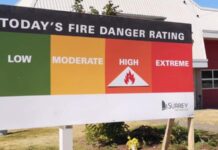THE Surrey Fire Service is reminding people on how to prevent carbon monoxide (CO) build up in your home by properly maintaining all fuel-burning appliances and installing CO alarms in your home. British Columbia’s first ever Carbon Monoxide Awareness Week runs from November 1 to 7 this year.
A working CO alarm should be installed on every floor of your home and next to each sleeping area. Make sure to test and clean the carbon monoxide alarms regularly and replace them according to manufacturer’s instructions.
What is CO?
- CO is known as the “silent killer” because it is an invisible, tasteless and odourless gas that can be deadly. CO is NOT natural gas – natural gas has a chemical called mercaptan added to it to make it smell like rotten eggs.
- CO is produced when fuels such as propane, gasoline, natural gas, heating oil or wood do not burn completely in fuel-burning appliances and devices.
Prevent CO in your home
- Ensure fuel-burning appliances, chimneys and vents are properly maintained, as well as cleaned and inspected annually. Visit www.technicalsafetybc.ca to find a licensed contractor near you.
- Never use barbeques, burners or generators inside garages, even if the garage doors are open. Only use them outside, away from all doors, windows, vents, and other building openings.
- Never use the stove or oven to heat your home.
- Always remove a vehicle from the garage immediately after starting it.
Know the symptoms of CO
- Exposure to CO can cause flu-like symptoms such as headaches, nausea, dizziness, as well as confusion, drowsiness, loss of consciousness and death.
- If your CO alarm sounds, and you or other occupants are suffering from symptoms of CO poisoning, get everyone out of the home immediately. Then call 9-1-1 or your local emergency number from outside.
Know the sound of your CO alarm
- Your CO alarm sounds different than your smoke alarm. Test BOTH alarms monthly and make sure everyone in your home knows the difference between the two alarm sounds.
- Don’t be confused by the sound of your CO alarm’s low-battery warning. Follow the manufacturer’s instructions so you know the difference between the low-battery warning, the “end-of-life” warning, and the alarm alerting you to the presence of CO in your home.
For more information related to carbon monoxide visit www.COsafety.tips












